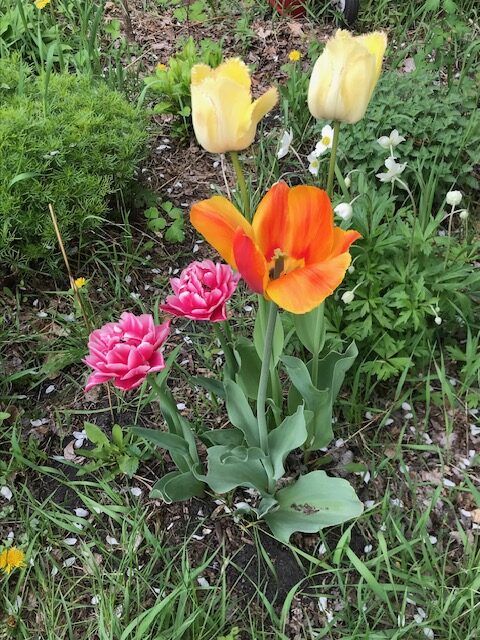Talking Plants
Jillian Patrie | University of Minnesota Yard and Garden Extension
October is perfect for planting bulbs that bloom in the spring, such as tulips, daffodils and crocus. Iris and peonies are best to plant or transplant in the fall as well. Here are a few tips for planting bulbs for beautiful springtime blooms.
Bulbs come in many shapes and sizes and sometimes it’s hard to tell how to plant them. Tulips have a top and bottom and are shaped like teardrops. The pointed end is the top and should be planted pointing toward the sky. In general tulip bulbs should be planted at a depth of 2x the bulb diameter, around 6-8” deep. Plant tulips and other bulbs together for a mass effect in spring. Bulb tone or other potash fertilizer can be used at the time of planting, which can occur until the ground freezes. Squirrels do like to dig up tulips and other bulbs, use an animal repellent or lay down chicken wire to avoid bulbs being lost to pesky squirrels.
Hyacinth, daffodils and other spring blooming bulbs are planted in similar ways. If you are transplanting or planting iris and peonies, fall is the perfect time. The key to success with these two springtime stunners is the planting depth. Iris do not like to be buried, when planting make sure the rhizomes are just below the soil level, same goes with peony, the stem and buds should be just peeking out of the soil, do not bury them.
Remember there are hardy bulbs (tulips, hyacinth, daffodil) and there are tender bulbs (begonia, canna, gladiolus and dahlias) that need to be dug up before the coldest part of winter.
For more information on planting tubers, bulbs and rhizomes for spring and summer blooms visit
https://extension.umn.edu/how/planting-bulbs-tubers-and-rhizomes.
Fall is a good time to finish last minute landscaping projects too. With the warmer temperatures this fall it is still safe to plant trees and shrubs. Perennials should be in the ground by the end of September. Watering new plantings is key, especially with the lack of rain we have been receiving. Water new trees and shrubs 2 times weekly with around 1” of water. Watering deeply is the best way to ensure trees and shrubs are getting enough water. Pruning can occur in the fall as well for certain landscape plants. Trimming the spent flowers on cone shaped hydrangea can happen in fall, late winter or spring. For more information on trimming hydrangea visit this article https://extension.umn.edu/planting-and-growing-guides/pruning-hydrangeas-best-bloom. Keep in mind when trimming shrubs and trees to only remove up to ⅓ of the height at a time.
Preparing lawns for winter is another fall task we should be thinking about as cooler weather arrives. Mowing, fertilizing, aeration, broadleaf weed control (perennial weeds) and dethatching can be done until late October. Dormant seeding a lawn can be done right before snowfall, avoid dormant seeding too early, the seed should not germinate until spring. For more information on lawn care timing check out this lawn care calendar https://extension.umn.edu/planting-and-growing-guides/lawn-care-calendar. For more information on dormant seeding a lawn visit this article https://extension.umn.edu/lawn-care/dormant-seeding.
For more information about this article or for local assistance please contact your local Clay County Extension Horticulture Educator Jill Patie at 218-299-7338 or by email at patri350@umn.edu.


